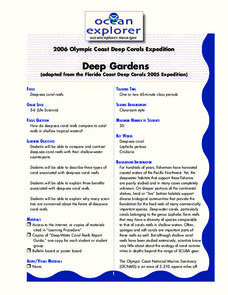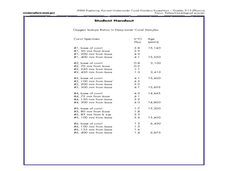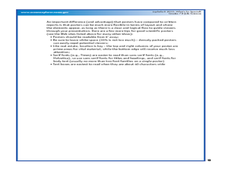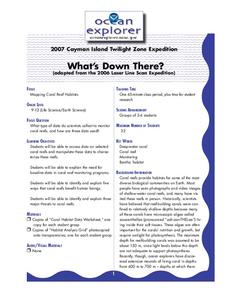Curated OER
What's the Connection?
High schoolers explain hardground communities in the Gulf of Mexico. For this deep-sea ecosystem lesson, students investigate the connection between deep-sea ecosystems and petroleum deposits. They discuss the relationship between...
Curated OER
Coral Reef Lesson Plan Caution: Do Not Bleach!
High schoolers explain five ways that coral reefs benefit humans and identify three threats to the reefs. They investigate the phenomenon of "coral bleaching" while examining ways to reduce threats to coral reefs.
Curated OER
Treasures in Jeopardy
Young scholars study how coral reefs can be protected from humans and their activities. In this conservation instructional activity students explain the benefits of coral reefs and what humans can do to help protect them.
Curated OER
Rainforests of the Sea
In this ecology learning exercise, students read and study about coral reefs using online resources to complete 8 short answer questions. They watch a video related to the topic.
Curated OER
Let's go to the Video Tape!
Using actual data from a deep-sea video survey, high school marine biologists consider the biodiversity, compare species richness between two communities, and learn to calculate the diversity index. The lesson plan is all-inclusive,...
Curated OER
Keep Away
Study biological diversity by analyzing given data, and make inferences about the possible effects of oil drilling operations on specific benthic communities. This lesson plan allows students to use their statistical analysis skills...
Curated OER
History's Thermometers
Ancient coral beds give scientists clues to past ocean temperatures in much the same way that tree rings indicate historical weather conditions. High school scientists examine coral oxygen isotope ratios and plot the data as a function...
Curated OER
Deep Gardens
Learners compare and contrast deep-sea coral reefs with shallow-water coral reefs. In this underwater ecology lesson, students describe three types of coral and explain why scientists are concerned about the future of deep-sea coral.
Curated OER
What's Down There
High schoolers write an essay about the coral reefs. In this oceanography instructional activity, students investigate the reef of Bonaire and compare it to reefs that are not thriving. High schoolers then explore the differences that...
Curated OER
Deep Gardens
Students investigate the differences and similarities between shallow-water and deep-sea coral reefs. In this coral reef lesson, students research and compare the characteristics of reefs. Students describe various lifeforms...
Curated OER
Design a Reef!
Students explore coral reef ecosystems. In this ecosystems science instructional activity, students research coral reef ecosystems to determine the major functions the participating organisms must perform. Students construct...
Curated OER
Coral Bleaching
Students examine the relationship between corals and zooxanthellae, identify stresses to corals, and explain coral bleaching. In this sea life lesson students predict the effects of increased temperatures on coral reefs.
NOAA
Community Ecology and Sampling
Seamounts in the Coral and Tasman Seas are home to more than 850 different species. Groups explore hydrothermal vents, researching the organisms found there and their energy source. They also learn about seamounts, exploring their unique...
Curated OER
How can deep-water corals be used to determine long-term patterns of climate change?
Students explore the concept of paleoclimatological proxies. In this paleoclimatological proxies lesson, students explain isotope ratios in deep water coral samples. Students write a paragraph about global climate change as...
Curated OER
Feeding in the Flow
The National Oceanic and Atmospheric Administration (NOAA) has developed a tremendous library of ocean-themed lessons that can be used in a variety of science settings. "Feeding in the Flow" is one of those activities; Its focus is on...
Curated OER
Make an Edible Coral Reef
Students create an edible coral reef out of food and candy. In this Science lesson plan, students explore what a coral reef is and the coral reef's importance to the ecosystem. Additionally, students discover the different parts of...
Curated OER
Blue Planet: Seas of Life
Learners study coral reefs and marine communities. In this investigative lesson students get into groups and are assigned a subject. In their groups they create a poster about their assigned topic.
Curated OER
Underwater Research
Students make transect and quadrat surveys using a provided worksheet in order to understand the techniques used to study coral reefs. Each type of survey is used to identify the species, diversity, and number of corals.
Curated OER
What's So Special?
Pupils study the biology and morphology of Lophelia corals. In this investigative lesson students explain how the coral contributes to communities, and create a poster.
Curated OER
Easy as Pi
Students describe the importance of structural features that increase surface area in a coral reef habitat. In this investigative lesson students quantify the impact of modifications on surface area in model habitats.
Curated OER
What's Down There?
High schoolers analyze data on coral reefs and use this to help characterize reefs. For this mapping coral reefs lesson students identify and explain the major threats to coral reefs.
Curated OER
Design a Reef!
Students design a functional model of a coral reef ecosystem. For this coral reef lesson, students identify the energy sources and material cycles of a coral reef. They write an essay about their niche in their own ecosystem.
Curated OER
Save A Reef!
Students identify the major threats to coral reefs and the ways that they benefit from humans. In this coral reef conservation lesson plan students create a public education program on coral reefs.
Curated OER
Fish Are Animals Too
Young scholars create posters that show how a shark is a major predator in kelp forests and coral reefs after studying the food webs for these ecosystems. They determine that fish are important animals in the ocean's web of life.

























